|
FEATURE
Destination Moon
Carolyn Gramling
Peace in Space?
Phases of the moon mission Print Exclusive
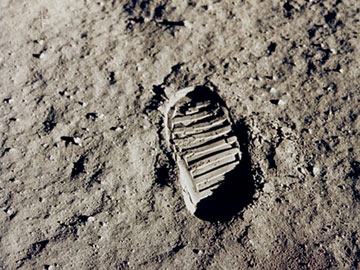 NASA |
| Edwin "Buzz" Aldrin, Apollo 11's lunar module pilot, left his bootprint on the moon in July 1969. |
“As I take man’s last step from the surface, back home for some time to come … I’d like to just [say] what I believe history will record — that America’s challenge of today has forged man’s destiny of tomorrow. And, as we leave the moon at Taurus-Littrow, we leave as we came and, God willing, as we shall return, with peace and hope for all mankind.”
On Dec. 17, 1972, Eugene A. Cernan, the commander of Apollo 17, said these words as he took a last look around at the stark moonscape of the Taurus-Littrow Valley on the southeastern rim of the moon’s Mare Serenitatis crater. Then, he and Harrison Schmitt, the lunar module’s pilot and the only geologist-astronaut to walk on the moon, stepped back into the lunar module one last time to return to Earth.
Due to NASA’s shrinking budget and to make room for the space shuttle program, Apollo 17 was the last of NASA’s pioneering manned missions to the moon. But even then, no one imagined that it would be more than three decades before humans returned.
Later this year, however, NASA plans to launch its first new missions to the moon in more than 35 years. The goal: To scope out likely spots to land and create a habitat where astronauts can stay for longer than the Apollo program ever dreamed.
But therein lies the controversy: Mars, with its potential stores of oxygen and water, has the highest potential for long-term human habitation. The moon, even in NASA’s manned spaceflight plans, isn’t supposed to be the primary destination for humans’ return to space. Some scientists are asking why we are working so hard to return to a place where we’ve already set foot.
NASA’s plans suggest that the lunar habitat is, to some extent, meant to be a kind of stepping stone, a field laboratory where scientists can test out new technologies, investigate how to mine the surface and figure out how to keep humans alive in the harsh lunar environment. It’s a classroom and staging ground before taking the much bigger and more dangerous leap to Mars.
Meanwhile, the moon is no longer the finish line in a race between two superpowers; instead, other nations are joining in. In addition to the U.S. and Russia, China, Japan, India and other nations have announced plans or have already launched missions of their own to assess and stake a claim in the new era of the space race.
An even bigger step for mankind
In January 2004, President Bush announced his “Vision for Space Exploration” to mixed reviews from Congress, scientists and the public. The announcement, on the heels of the 2003 space shuttle Columbia disaster, promised a new era of human spaceflight, retiring the aging space shuttles by 2010 and developing instead a new crew exploration vehicle called Orion. The vision was ultimately to “extend human presence across the solar system and beyond” — but first, to initiate a program to explore the moon, with not only scientific but also commercial and national goals.
In September 2005, NASA responded with a $100 billion plan called Project Constellation, a multi-component program to build the next generation of spacecraft for human spaceflight, to maintain the U.S. presence in low-Earth orbit and to lay the foundation for Mars exploration and beyond. The project includes plans to put four astronauts on the moon for a weeklong stay by 2018.
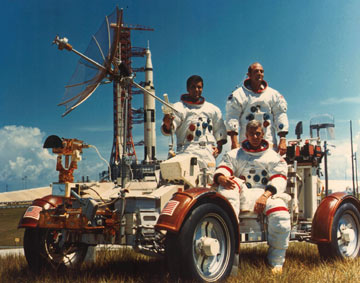 NASA |
| Apollo 17's crew — Lunar Module Pilot Harrison H. Schmitt, Command Module Pilot Ron Evans and Commander Eugene A. Cernan — pose in the moon rover during preparations for the last Apollo mission, which launched in December 1972. |
The first, unmanned phase of the program is scheduled to launch later this year, and includes NASA’s Lunar Reconnaissance Orbiter (LRO), which will spend a year orbiting the moon, mapping its surface, radiation and gravity fields, looking for potential resources and finding new landing sites. Identifying safe places for a manned lunar lander to set down is key, as recent data from Earth-based radar signals suggest that the terrain near the moon’s south pole is much more rugged than once thought, with peaks as high as Alaska’s Mount McKinley and crater floors deeper than the Grand Canyon.
Along for the ride on the same launch vehicle will be the Lunar Crater Observation and Sensing Satellite (LCROSS), whose mission is to confirm whether frozen water exists at the moon’s south pole. Data from NASA’s Lunar Prospector Orbiter in 1998, which closely examined the poles, suggested that the dark, cold polar regions of the moon contain abundant hydrogen atoms, which could be signs of water.
Because that water may be buried up to half a meter beneath the soil and loose rock fragments covering much of the moon’s surface, the LCROSS mission is designed to go below the surface to find that evidence. After reaching orbit in 2009, LCROSS will split into two parts: A 2,000-kilogram vehicle that will crash into a dark crater near the pole hard enough to kick up that buried material, and a satellite that will observe the composition of that dust.
Meanwhile, plans for manned missions to the moon are under way. The Vision for Space Exploration includes the development of a crew exploration vehicle called Orion, which will be similar in shape to the Apollo spacecraft but somewhat larger — big enough to carry four astronauts to the moon (or six, if the destination is the International Space Station).
The launch of the new moon missions will be considerably different from the Apollo missions, however. Instead of a single launch, the unmanned lunar lander will be launched first aboard the heavy-lifting cargo launch rocket Ares V, while the Orion spacecraft will follow in a second launch aboard the sleek Ares I rocket. Once in a low-Earth orbit, the two pieces will link up and begin their journey to the moon.
Those lunar missions will play a crucial role in moving manned spaceflight forward, NASA says, by providing a short-distance test run for other manned expeditions, including missions to Mars, which would be much longer and require at least 500 days on the planet’s surface, not to mention the roughly 250 days to get there.
“I view my job as building transportation infrastructure to get to Mars eventually,” says Richard Gilbrech, who, as head of NASA’s Exploration Systems Mission Directorate in Washington, D.C., is helping to orchestrate the Constellation missions. “We would much rather go three days away from home than a 30-month journey with no possibility of rescue or return,” Gilbrech says. “There is a wealth of technologies that has to be proven.”
Moon rush
The United States is not alone in racing to begin new moon programs and launch satellites to explore the lunar surface and assess its resources. In September 2007, Japan successfully launched its first lunar orbiter, SELENE. SELENE’s objectives during its one-year mission are to map the moon’s surface, study its gravity and take the first high-definition images of the moon from space. India’s first moon mission, Chandrayaan-1, is set to be launched this year.
Meanwhile, last October, the Chinese National Space Administration launched the satellite Chang’e-1 (named for the Chinese goddess of the moon), in collaboration with the European Space Agency, which provided ground support and tracking data from its SMART-1 mission.
Chang’e-1’s goals include orbiting the moon for a year, taking images of the lunar surface, analyzing the chemical elements on the surface, measuring the depth of the soil and observing space weather in the Earth-moon space. China plans to follow up the satellite with a lander and rover by 2012, robots to bring back samples by 2017 and possibly sending a taikonaut — a Chinese astronaut — by 2020.
Moon mining
Although national pride may be one reason for the new international push to the moon, another may be its potential resources. In addition to the hunt for water, which would be critical to the success of a future lunar outpost, new technologies are being developed to extract oxygen from the soil and rocks, or “regolith,” on the moon’s surface, Gilbrech says.
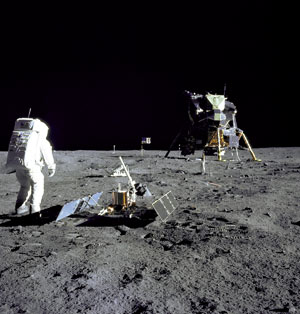 NASA |
| Buzz Aldrin deploys scientific equipment on the moon in July 1969. |
The hydrogen locked in the ice could also be a potential source of fuel, and such a readily available fuel source on the moon would facilitate Earth-moon travel, he says. “We’re trying to get to the point where we don’t have to launch everything from Earth, and can start making some things locally,” he adds. “If we can develop components or tools or solar arrays [on the moon], that would be a huge shift.”
Between the absence of clouds and the moon’s slow rotation, solar arrays could also be a potential source of power, particularly at the poles. Data from NASA’s 1994 Clementine mission suggested that, during the moon’s summer, the rims of some craters near the moon’s north pole were in constant sunlight for an entire lunar day — equivalent to 29 Earth days.
The moon may also contain a potentially valuable future energy resource in the form of the isotope helium-3. Helium-3 is a small component of solar wind, streams of charged particles ejected from the sun that have bombarded objects in the solar system for billions of years, says nuclear engineer Gerald Kulcinski of the University of Wisconsin at Madison. Helium-3 exists in Earth’s interior, but there is little at the surface; planets with a magnetic field or an atmosphere — including Mercury, which has a magnetic field, Venus, which has a thick atmosphere and Earth, which has both — are protected from the plasma streams, and thus don’t accumulate the isotope. That leaves the moon as the closest object in the solar wind’s path, and helium-3 has been piling up in the regolith for 4.5 billion years, Kulcinski says.
The isotope’s importance lies in its potential to become a clean source of nuclear energy, Kulcinski says. “We never think of the moon as a source of energy, but there’s 10 times more energy in helium-3 on the moon than there ever was in fossil fuels on Earth,” he says.
Fusing two atoms of helium-3 together produces an efficient, long-lived fuel with no radioactivity — an improvement over today’s commercial nuclear energy, produced by the fission, or splitting apart, of the nucleus of uranium or plutonium atoms. Researchers are also investigating energy produced by the fusion of two isotopes of hydrogen, deuterium and tritium, which produces shorter-lived waste — but that reaction also generates large amounts of damaging radioactivity.
But the helium-helium reaction is very difficult to produce in the laboratory, and the technology to make helium-3 mining commercially viable does not yet exist, Kulcinski says. Still, he says, some countries, particularly Russia, China and Japan, have expressed an interest in mining the isotope on the moon. NASA acknowledges helium-3 as one of many potential moon-based commercial applications, but only much further down the line, Gibrech says. “Our main task is creating capability — we’re envisioning this not just as a NASA lab, but a feeder for industrial and commercial activities.”
Science missions
To geologists, the moon is, of course, much more than a way station on the path to Mars and other more distant destinations. In 2007, the National Academy of Sciences’ Space Studies Board released its final report outlining the scientific research objectives for a lunar return, citing the moon’s nearly pure 4.5-billion-year-long record of solar system history, unaltered by crust recycling, volcanism or erosion.
And in addition to the clues it contains about meteoric bombardments and the formation of the planets in the inner solar system, the moon holds promise in other scientific arenas, NASA researchers say. Sitting squarely in the solar wind flowing from the sun, the moon can act as a laboratory from which to observe plasma physics, as well as observations of Earth’s own atmosphere, ionosphere and magnetosphere.
Another long-cherished dream of astronomers has been the construction of an array of radiotelescopes on the far side of the moon to detect very-low-frequency (VLF) radio waves, signals from the formation of the precursors to star clusters and galaxies forming in the “Dark Ages” of the universe — its first 100 million years, a time when the cosmos was filled with cosmic background radiation rather than stars. VLF signals are nearly impossible to detect on Earth because the planet’s ionosphere, as well as radio and television transmissions, create too much noise. But the far side of the moon, astronomers say, is fully shielded from this terrestrial interference. In February, NASA awarded grants to two teams of astronomers, one led by MIT researchers and the other by scientists at the U.S. Naval Research Laboratory, to develop plans for such an array over the next year, with construction scheduled to begin sometime after 2025.
To the moon … or Mars?
But to some scientists pushing for humans to reach Mars, these missions are just drawing attention — and money — away from that goal. “The Constellation program is not widely perceived as a Mars program, and that’s a mistake, because it doesn’t garner the public interest it should,” says Louis Friedman, executive director and co-founder of The Planetary Society in Pasadena, Calif. “I have respect for NASA’s point of view — that they want to get their sea legs back at the moon,” Friedman says. “They have to use the moon as a stepping stone. But they don’t have to stay there, or build a base. If we accept that the idea of humans getting to Mars is the goal, the question is, what do we do to get there?”
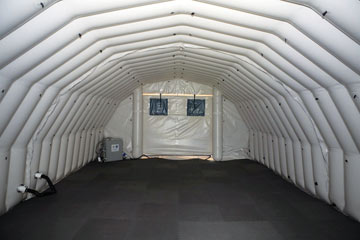 NASA |
| In January, NASA shipped this prototype inflatable habitat to McMurdo Station, Antarctica. The habitat — possible future moon housing — will be tested for a year in Antarctica's cold, harsh environment. |
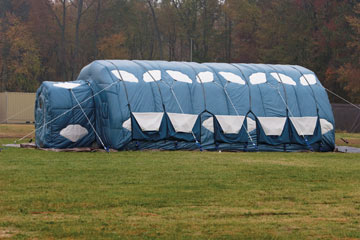 NASA/JSC |
Space travel is both very expensive and very risky, so the value of the missions should be high to match, Friedman says. “In the case of humans going to Mars, the value is very, very high — that is the only place that we can determine the future of the human species off the planet. It’s the only planet that we can conceive of that we can reach that may have harbored life and can in the future.”
The scientific and commercial goals for the moon program alone — such as VLF telescopes and mining for resources — are simply less vital, Friedman says. “If it does make sense to somebody to mine … helium-3 or build large telescopes, then fine, that can be a goal in itself. But it should not be an interim goal on the way to Mars.”
Some scientists have proposed using “near-Earth objects” (NEOs), such as large asteroids, as stepping stones to Mars rather than building a more expensive and time-consuming habitat on the moon. For one thing, astronauts wouldn’t need landing gear to land on these smaller, nearly gravity-free objects, and the costs could be considerably cheaper. Furthermore, NEOs would be interesting to study. But they are still not the goal, Friedman emphasizes. Connecting the interim points — asteroids, the moon — back to a manned Mars mission would help to sustain the program, but “if each program becomes an end in and of itself, that’s discouraging. You lose public interest right at the beginning.”
That’s not how NASA views it, Gilbrech says. “To say that we’ve exhausted all the scientific interests … seems misguided.” As for public interest in moon missions, he adds, “I think the support is there.” Indeed, another measure of the public enthusiasm for the moon program, Gilbrech says, is international interest. “It’s not like Apollo, when it was just us and the Russians. When you look at all the missions being planned to go to the moon, it’s very much becoming a global framework of activity.” In fact, the return to the moon is not so much a “race” as it is the beginning of a long-term occupancy — not unlike staking a claim in Antarctica, he says. “It’s equivalent to racing to reach the South Pole versus putting a base down there. We’re putting a base on the moon.”
NASA hopes, in fact, to tap into that international interest in moon exploration and stimulate competition among international companies for some of the aspects of its lunar missions. “Some things we’ll hold on to, like spacesuit design, navigation and communications, and the lunar lander,” Gilbrech says. “But outside of that, we’re opening up other elements to commercial and international participation.”
As nations proceed with their proposed moon missions, to what extent they will be composed of international collaboration as opposed to competition — or, more likely, some combination thereof — remains to be seen. That international interest is vital to the success of space programs, however, is something on which all parties can agree. “For human spaceflight to really get public funding, it needs to serve an international goal — we learned that with the International Space Station,” Friedman says. “We couldn’t do it domestically because we wouldn’t get political support and the budget, and the same is even more true of Mars.” One concern, he adds, is that as the economy, global climate change and ongoing war efforts place more strain on the U.S. economy, a new administration will be under pressure to slash human space exploration from the budget. “We don’t want the concept to be thrown away because of certain deficiencies in the program,” he says. “We don’t want to throw the baby out with the bathwater.”
NASA, meanwhile, is focusing on the tasks at hand — the upcoming robotic launches, building its spacecraft and assessing the future habitability of the lunar environment, Gilbrech says. The current priority, he says, is “to be back with human boots on the moon by 2020.”

 Subscribe
Subscribe


